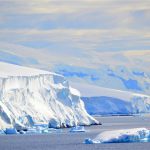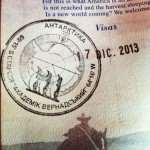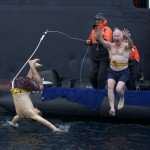
Comments and emails like the one below are not uncommon since my voyage to Antarctica on Silver Explorer last month:
I normally hate the cold but have a yen to go to Antarctica My husband doesn’t want to go; says the journey would be horrendous. He an ex-747 captain; me, an ex-stewardess, so we have traveled extensively. We will both be 70 next year, although still fairly active. Do you think we would cope, and should I twist his arm! — Sara
My response:
I was nervous too, but the journey did not even come close to being horrendous. Quite the opposite — it was one of the best experiences of my life, and I would go back in a heartbeat. We had 5-meter (15-foot) seas on the first morning in the Drake Passage. Yes, they were lumpy and bumpy, but I would endure twice that or more to visit Antarctica again. Think about it: The crew does this voyage every 10 days. Surely, you and your husband can deal with it, and if you’re lucky, you’ll cross “Drake’s Lake” each way, with minimal motion. On the other hand, if you’re unlucky, you’ll have a great story — and I promise you, you’ll forget about the rough seas when you step ashore in Antarctica. Go!

All Aboard: My Voyage In December
I was fortunate. Silversea Cruises hosted me, along with three other journalists from the United Kingdom and one from Russia, on an 11-day voyage between Ushuaia and Antarctica. Silversea wanted us to experience the voyage so that we could write about it and, in doing so, perhaps help people like Sara make informed decisions about whether or not she should twist her husband’s arm.

During my voyage and since disembarking Silver Explorer on December 22, I have written about cruising Antarctica extensively, more than 15,000 words for our sister site Live Voyage Reports. You’ll find links to my daily reports at the bottom of this post.
I still have more to write in the coming weeks as well as a photo slideshow and a video to produce. Cruising to Antarctica and stepping ashore on the continent requires a lot of digital acreage to adequately convey the experience.
I would not have had so much to write about had I not stepped ashore on the continent as often as I did during our voyage, which raises an important point: If cruising Antarctica is in your future, the first thing you’ll want to consider is whether to cruise by or step ashore.
Drive-Bys vs. Landings
There are essentially two ways to cruise Antarctica: on a large ship that cruises by or on small ones that conduct landings.
During the 2013-2014 austral summer, nearly 10,000 travelers will cruise by Antarctica. They’ll be sailing on 500-plus-passenger vessels that are allowed to operate “cruise-only” voyages, with no landings permitted in Antarctica.
During the same period, a couple dozen ships under the 500-passenger threshold will land more than 23,000 people in Antarctica throughout the season. Those ships range in capacity from 48 passengers to 462 passengers, according to documents filed by the International Association of Antarctica Tour Operators (IAATO).
As an aside, nearly 1,600 passengers will skip the Drake Passage altogether by flying between South America and King George Island, where they will board ships for (primarily) one-week sailings with landings. My advice: Experience the Drake Passage, for better or worse. It is a rite of passage.
If you need courage to cruise the Drake, follow in the wake of Silver Explorer’s Expedition Team Leader Kara Weller. She was making her 112th trip to Antarctica during our voyage. She has crossed the Drake Passage more than 200 times (not every trip was from South America, so Kara also crossed other potentially rough passages from Australia and New Zealand). If Kara can cross the Drake Passage more than 200 times, you certainly can do it once — especially if you’re someone who has flown 747s (wink, wink).

Once you’ve decided whether to cruise by or step ashore, your next decision is which ship to call home for the duration of your voyage. If you’re planning on stepping ashore, you’ll need to choose a ship that carries fewer than 500 passengers. I’ve only been on one in Antarctica, and I give her high marks. Aside from its 1A ice-rated hull, Silver Explorer has at least five distinctions that make it a good choice for cruising Antarctica.
1. Antarctica Is Big, But You Should Think Small
Because of its low passenger capacity, Silver Explorer allows for multiple daily landings in Antarctica.
Guidelines drawn up by the IAATO stipulate that no more than 100 visitors shall be ashore at any one time in any one place in Antarctica. The goal is to protect the planet’s largest wilderness area by practicing environmentally responsible travel.
Therefore, it stands to reason that the fewer passengers traveling along with you, the more time you will be able to spend ashore. And you want time ashore in Antarctica. That’s where all the action takes place.

If you want up-close encounters with penguins and seals (along with opportunities for great photographs of wildlife), you must get your boots on the ground in Antarctica. In addition to experiencing the wildlife, you’ll walk on glaciers, hike mountain ridges and visit research stations. There’s something about standing on the continent that appeals to my sense of the adventure — and likely yours too. You will want to go ashore and probably as often as possible.
With a capacity for only 132 guests, Silver Explorer is able to rotate all guests ashore efficiently so that at least two landings can be executed each day. During the 5.5 days that Silver Explorer was in Antarctica on my voyage, I participated in all 11 landings. (My voyage spanned 11 days, including one day embarking in the late afternoon and one disembarking in the early morning. Of the remaining nine days, we spent about 3.5 days on speedy sailings through the Drake Passage, leaving 5.5 days in Antarctica.)
Moreover, because of the size of Silver Explorer, there was seldom, if ever, any waiting for zodiacs between ship and shore.
2. Yes, You Want Champagne, Caviar & A Butler
Silver Explorer is the smallest luxury cruise ship operating in Antarctica. In case you missed it, the emphasis in the preceding sentence is on luxury. You can cruise on smaller ships, but you won’t get the luxury experience on ships smaller than Silver Explorer.

You may not think you need gourmet cuisine, complimentary beer, champagne, wine and spirits — as well as speciality coffees and full-on tea service — butlers, spacious suites and staterooms, fitness center, room service and a high staff-to-guest ratio (120 crew/114 guests on our voyage), but those who experienced the luxury comforts on Silver Explorer told me they would not have it any other way. I don’t know that I would either.

You could certainly save a few shekels by notching down the quality of your experience, but you may only get one shot at visiting Antarctica. Metaphorically speaking, do you want to fly Economy Class or Business (or First) Class? Stay at Ritz-Carlton or Holiday Inn? This is not the time — or place — to pinch pennies. Optimize your experience on a small, luxury ship.
3. The Luxury Of Learning
If your goal is to experience and learn about Antarctica, you will not be disappointed. Silver Explorer’s Expedition Team makes for not only a truly enjoyable voyage but also an edifying one.
On our voyage, there were 11 expedition team members. Each had an expertise in a discipline that related to some aspect of our voyage. We had first-hand access to marine biologists, geologists, glaciologists, climatologist and more. It was like having human Wikipedias along with us each step of the way.

Members of the expedition team were always available, and their expertise, whether through the presentations they made or one-on-one interactions, was invaluable to our voyage.

We learned quite a bit ashore and supplemented our new-found knowledge back on the ship at the “Recap & Briefing” as well as at presentations such as the following that took place during our time on board:
- “Demon Fish — The Ultimate Predator” about Orcas, which we saw on our voyage
- “Climate Change — The Global Carbon Experiment”
- “Polar Phenomena: Inspiration Icons Of Earth’s Ice Realms”
- “Hot Blood, Ice Water,” about seals
- “Terra Australis Incognita: Heroes of the Exploration of Antarctica”
- “Penguins”
- “Ocean Wanderers: Seabirds of the Southern Ocean”
- “Wealth in the Waters: A History of Antarctic Whaling”
- “A Continent for Peace and Science”
- “Cryosphere; Where The World Is Frozen”
- “Life Under Ice: Invertebrates of Antarctica”
The presentations were well-attended, entertaining and educational. I stepped off Silver Explorer with knowledge that I now share at parties and dinner tables. For example, did you know that a seal’s whiskers have ten times as many nerve fibers as found in rats and mice? That allows seals to detect a fish’s trail up to 35 seconds after it has passed and up to 130 feet away. Now you know why you don’t see many skinny seals resting on beaches. They’re agile hunters, even in murky waters.
4. Silver Explorer Boasts Spacious Staterooms, Especially For A Small Ship

As previously mentioned, Silversea hosted me on this voyage, along with videographer Chris Stanley. Chris and I shared a Medallion Suite, number 702, situated on Deck 7, the Viewing Deck.
There are only six suites on Deck 7: two Grand suites, measuring 618 square feet, with verandas measuring 86 square feet; and two Owner’s suites, measuring 728 square feet, with verandas measuring 158 square feet; and two Medallion suites.
Our Medallion Suite measured 400 square feet; 86 square feet of that was veranda. We had a small sitting area, twin beds, a writing desk, flat-panel television with 80-plus on-demand movies and music, plus satellite news programming — and a huge bathroom with separate shower and tub.
Similar in square footage to our Medallion Suite are the Silver and Expedition suites, measuring from 388 square feet to 422 square feet.

There were five categories of suites that were smaller than ours: Veranda, Vista and View suites, ranging from 192 square feet to 216 square feet, and the Explorer and Adventurer classes, ranging from 157 square feet to 190 square feet. All of these were situated on decks three, four and five.
5. Silver Explorer’s Crew Exceeds Expectations
I don’t want to take away credit from any other luxury cruise line, because all either meet or exceed expectations, but on this particular voyage on Silver Explorer the staff exceeded expectations of all guests who I spoke with. They were not only highly polished but also personable and eager to please.
With 120 of them on board and only 1114 of us, no wonder they appeared relaxed and unhurried. They knew every guest by name, and a lot of us also knew each crew member by name. The atmosphere was warm and welcoming.

The voyage was under the command of Captain Adam Boczek and under the management of hotel director Sujith Mohan. I heard nothing but good things about their leadership skills. The captain kept us informed all along the voyage, and he outran a storm that would have made our Drake Passage crossing more memorable (and perhaps not in a good way) than it turned out to be.

For his part, Mohan was always visible and available. He dined with guests each night of the voyage to assure that everyone’s expectations were being met, and in the rare case that they weren’t, he took action immediately, making notes on an electronic tablet. “Please don’t wait until the end of the voyage to tell me if there is something we can do to make your experience more enjoyable,” he told guests at our table one night. Mohan has worked his way up through the ranks so he knows each department’s responsibiities intimately and has his crew’s respect.

Our chef, Christian Armster, performed magic at mealtimes. The ship could only be provisioned once, when leaving Ushuaia, yet Armster managed to create gourmet dining experiences, breakfast, lunch and dinner — and in between.
At the captain’s table during one night of our voyage, a Swiss couple who had been traveling in South America for more than a week remarked that Armster’s rendition of Argentine beef was the best they had had so far, which is quite a claim in a nation that it known for its beef.
It’s also worth noting that Armster prepared meals for many nationalities, catering to the tastes and customs of each. We had a significant number of Chinese on board — as well as Australians, Europeans, Americans and Asians.
Dining was one of the highlights on a voyage full of highlights, and we have Armster to thank for that.

The ship’s musician, Lou, kept us entertained during the day and also at the Panorama Lounge each evening (to paraphrase ABBA, “Thank you for the music Lou”).
At every turn, we encountered genuinely happy crew. The ship’s security officer Franco always had a smile when we embarked or disembarked Silver Explorer for our zodiac excursions.
Waiters at the world’s best restaurants could probably learn a thing or two from our Silver Explorer waiter, Stephen, who always had a smile and surprised us by remembering our preferences or by suggesting something we would appreciate.

Back to our reader who prompted this post: Sara, twist your husband’s arm, both arms if necessary, and get yourselves on a cruise to Antarctica. You’ll find the experience to be not only enjoyable but also edifying and enlightening, and no doubt, you’ll return changed a bit by the grandeur and spectacle of having seen and walked among the world’s largest wilderness in a place that few others have visited, the White Continent, Antarctica.
Silver Explorer Voyage 7327, recapped …
- Day 1 – Arriving At The End Of The World: Ushuaia, Argentina
- Day 2 – Sailing The Dreaded Drake
- Day 3 – Today, A Big Surprise
- Day 4 — Destination: Mainland Antarctica, It Only Gets Better
- Day 5 – Brilliant Sunlight, Beautiful Bay, Awesome Antarctica
- Day 6 – The Polar Plunge & Vodka At A Remote Outpost
- Day 7 – Change Of Plans: Ice-Choked Channel Causes Us To Miss Port Lockroy, But …
- Day 8 – Visiting A Volcano & A Rough Ride Ahead?
- Day 9 – Drake Passage Redux: Calm Before The Storm?
- Day 10 – The Race To Beat The Storm Through The Drake Passage
- Day 11 – Back In Ushuaia, End Of A Voyage & Our Recap



